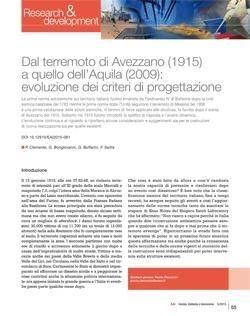Le prime norme antisismiche sul territorio italiano furono emanate da Ferdinando IV di Borbone dopo la crisi sismica calabrese del 1783 mentre le prime norme dopo l’Unità seguirono il terremoto di Messina del 1908 e una prima valutazione delle azioni sismiche, in termini di forze applicate alle strutture, fu fornita dopo il sisma di Avezzano del 1915. Soltanto nel 1975 furono introdotti lo spettro di risposta e l’analisi dinamica. L’evoluzione continua e al riguardo si riportano alcune considerazioni e suggerimenti sia per le costruzioni di nuova realizzazione sia per quelle esistenti
From Avezzano (1915) to L’Aquila (2009) earthquake: evolution of design criteria
The paper analyzes the evolution of the anti-seismic design criteria presenting and discussing the changes in the seismic code in Italy. A brief presentation of the main earthquakes that hit the peninsula in the 20th centuriy is given, and the subsequent evolution of the code. The first law, which gave rules for buildings, was issued by Ferdinand IV de Bourbon, king of the Two Sicilies, in the 1784, after the seismic event in the Calabria and Sicily regions in 1783, Macro-seismic Intensity XI. Already other significant earthquakes were remembered at that date, especially the one of 1693 in Val di Noto, Sicily, with a 7,4 estimated magnitude. According to the above mentioned law, rules for minimal dimensions of structural elements, masonry walls and foundations, were given, as well as specific prescriptions on the connection between walls and roof. Interesting regulations for reconstruction were also given by pope Pio IX after the earthquake of 1859 in Norcia.th 1909, a list of municipality classified as seismic ones was proposed. This list was progressively updated but only after earthquakes. Seismic forces in structural design were introduced by the D.L. n. 1526 of November 5th 1916, after the Marsica earthquake, with an almost constant distribution of the acceleration along the building height, not accounting for the actual dynamic behavior of the structures. Only after the n. 64/1974 law and the subsequent seismic code (DM of March 3rd 1975), modal and spectrum analyses appeared. Seismic check could be carried out by means of the static analysis, with horizontal acceleration linearly increasing along the height simulating the first mode of a cantilever beam, or by the dynamic analysis, with modal contributions combined according with the SRSS rule.
The DM 16/01/1996 introduced important innovations, such as the importance factor and the possibility of using the limit state design in seismic areas, and the coefficients for load combinations and material strengths were fixed. Furthermore, a specific section was dedicated to existing buildings, in which the seismic improvements and the complete seismic upgrading were distinguished.
Finally, in the wake of the more recent earthquake, the OPCM 3274/2003 and then the DM 14/01/2008 aligned the Italian rules to those of the Eurocode 8. The old classification of the territory, based on administrative boundaries, was substituted by a punctual definition in the territory of the seismic parameters needed to plot the elastic spectra.
Some observations about the current code and some suggestions to improve the prevention efforts both for new and existing structure are given


